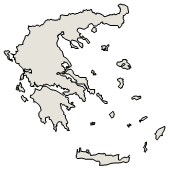| Municipal unit Siteia |
| Municipal Community Siteia |
| Agia Fotia (Αγία Φωτιά, η) |
| Anemomylia (Ανεμομύλια, τα) |
| Gianysada (Γιανυσάδα, η (νησίς)) |
| Dragonada (Δραγονάδα, η (νησίς)) |
| Paximada (Παξιμάδα, η (νησίς)) |
| Petras (Πετράς, ο) |
| Siteia (Σητεία, η) |
| Trypitos (Τρυπητός, ο) |
| Community Agios Georgios Siteias |
| Agios Georgios (Άγιος Γεώργιος, ο) |
| Epano Episkopi (Επάνω Επισκοπή, η) |
| Sotira (Σωτήρα, η) |
| Community Achladia |
| Achladia (Αχλάδια, τα) |
| Kimouriotis (Κιμουριώτης, ο) |
| Paraspori (Παρασπόριον, το) |
| Community Exo Mouliana |
| Exo Mouliana (Έξω Μουλιανά, τα) |
| Community Katsidoni |
| Katsidoni (Κατσιδώνιον, το) |
| Σανδάλιον, το |
| Sitanos (Σίτανος, η) |
| Community Krya |
| Dafni (Δάφνη, η) |
| Epano Krya (Επάνω Κρυά, τα) |
| Kato Krya (Κάτω Κρυά, τα) |
| Riza (Ρίζα, η) |
| Skordilo (Σκορδίλον, το) |
| Community Lastros |
| Agio Pnevma (Άγιον Πνεύμα, το) |
| Lastros (Λάστρος, η) |
| Community Maronia |
| Maronia (Μαρωνία, η) |
| Community Mesa Mouliana |
| Kalavros (Καλαβρός, ο) |
| Mesa Mouliana (Μέσα Μουλιανά, τα) |
| Community Myrsini |
| Myrsini (Μυρσίνη, η) |
| Community Piskokefalo |
| Kato Episkopi (Κάτω Επισκοπή, η) |
| Piskokefalo (Πισκοκέφαλον, το) |
| Community Praisos |
| Agios Spyridon (Άγιος Σπυρίδων, ο) |
| Kalamavki (Καλαμαύκι, το) |
| Nea Praisos (Νέα Πραισός, η) |
| Community Roussa Ekklisia |
| Διόνυσος, ο |
| Roussa Ekklisia (Ρούσσα Εκκλησία, η) |
| Community Skopi |
| Xerokampos (Ξερόκαμπος, ο) |
| Panagia Faneromeni (Παναγία Φανερωμένη, η) |
| Papadiokampos (Παπαδιόκαμπος, ο) |
| Sarantapichos (Σαραντάπηχος, ο) |
| Skopi (Σκοπή, η) |
| Community Stavromenos |
| Arniko (Αρνικόν, το) |
| Zou (Ζου, η) |
| Kato Drys (Κάτω Δρυς, ο) |
| Stavromenos (Σταυρωμένος, ο) |
| Community Sfaka |
| Agios Andreas (Άγιος Ανδρέας, ο) |
| Sfaka (Σφάκα, η) |
| Community Tourloti |
| Mochlos (Μόχλος, ο) |
| Tourloti (Τουρλωτή, η) |
| Community Chamezi |
| Chamezi (Χαμέζιον, το) |



